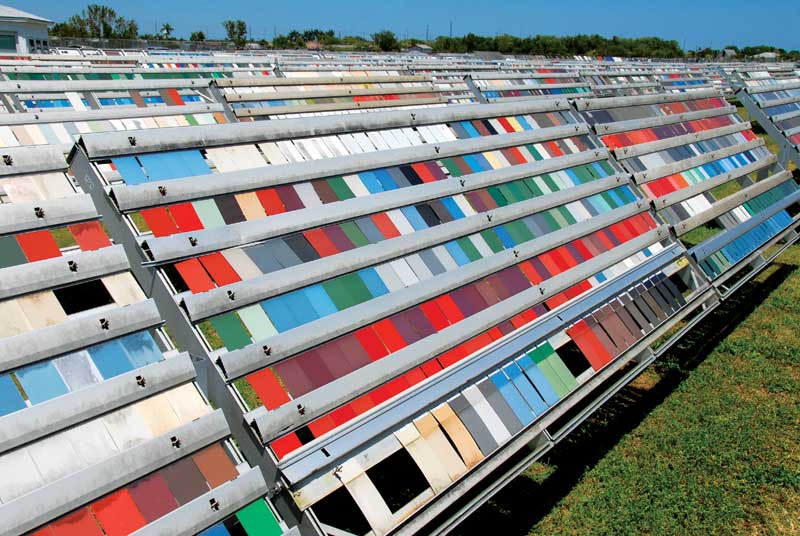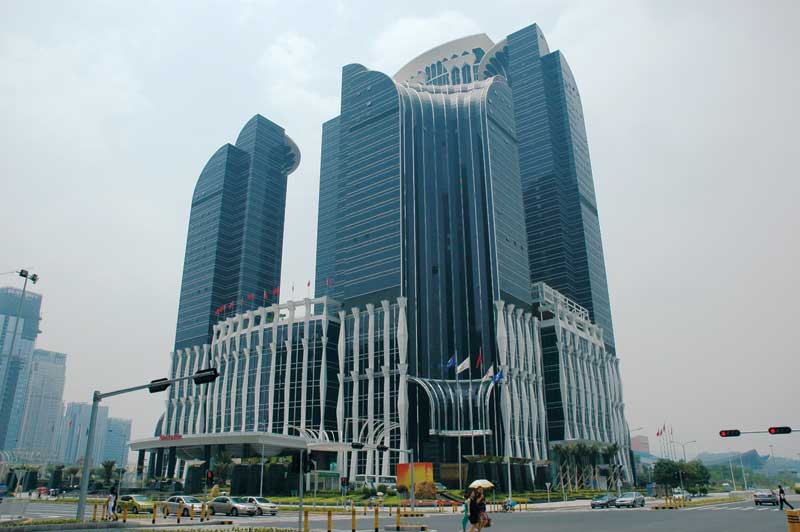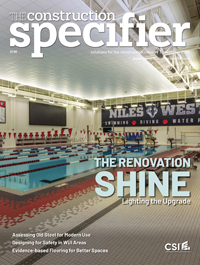Aluminum curtain wall coatings on 21st century façades

Testing facilities can further accelerate the weathering process by using ‘concentrators’ with an array of mirrors to reflect and concentrate full spectrum sunlight onto test specimens. The concentrators are capable of tracking the sun throughout the day in both azimuth and elevation. The combination of mirrors and tracking maximizes the amount of UV exposure that a test specimen receives. These accelerated natural weathering devices can quickly produce extremely useful data concerning the durability of products. Depending on the product that is being tested, companies can specify ‘misting’ to simulate rainfall or morning dew. Again, this is for the purpose of simulating real-world installations.
What products meet the standards?
An expanding array of coatings options—both powder- and liquid-applied—can lead to confusion regarding which will comply with a given AAMA standard. Compounding the confusion is an erroneous belief powder-applied coatings are chemically different than their liquid-applied counterparts.
All paints, regardless of whether liquid or powder, are made of two principal ingredients: resin and pigment. Liquid paint has solvents that act as a vehicle to deliver the resin and pigment to the substrate. Powder coatings are applied in a finely ground form, without the use of solvents. It is the resin that provides the film with mechanical characteristics, such as gloss and gloss-retention, as well as resistance to abrasion, scratching, and dirt accumulation. Pigments provide the color of the painted surface, and are responsible for the color change or fade as they degrade over time. Regardless of whether a coating is applied as a liquid or powder, as long as the resin and pigment chemistry are comparable, the finish will meet the same weathering criteria.

Of the resin types most commonly used to coat aluminum substrates:
- conventional acrylic and high solids polyester liquid coatings, as well as standard durable polyester powder coatings, will meet AAMA 2603 requirements;
- silicone polyester and 50 percent polyvinylidene fluoride (PVDF) liquid coatings, as well as super-durable polyester powder coatings, will meet the requirements of AAMA 2604; and
- 70 percent PVDF liquid or powder coatings or fluoroethylene vinyl ether (FEVE) liquid or powder coatings will fulfill requirements for AAMA 2605.
Fluoropolymer resins are fluorocarbon-based polymers commonly referred to as ‘new generation’ coatings. The most widely known fluoropolymer resins available to the fenestration industry are PVDF and FEVE. Depending on the manufacturer, AAMA 2605 finishes are available with up to a 20-year warranty.
Put your finish first
The structural systems of skyscrapers have been almost completely reinvented since the building type’s early days—in fact, a continuing evolution of their structural systems is what allows skyscrapers to be built ever taller. Building envelope technology has seen incremental, not overarching development. Nevertheless, wall systems must be technologically sufficient to meet contemporary standards of durability. Secondary components of the system, such as finishes, also need to be carefully considered. By understanding state-of-the-art pretreatment method as well as the standards governing architectural coatings, and by specifying the correct coating for each skyscraper’s individual needs, the service life of the entire structure can be optimized.
Ben Mitchell, CSI, is the extrusion coatings sales and marketing manager for AkzoNobel, a global paints and coatings company and producer of specialty chemicals. He has a bachelor’s degree in comprehensive science from Urbana University in Ohio. Mitchell started at AkzoNobel in 1990 as a lab chemist formulating polyvinylidene fluoride (PVDF) coatings, before moving into product management. He can be contacted at ben.mitchell@akzonobel.com.



